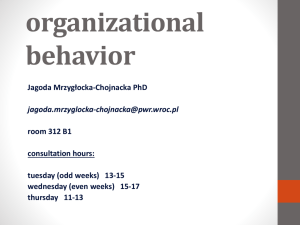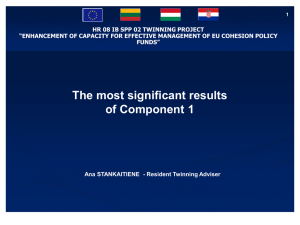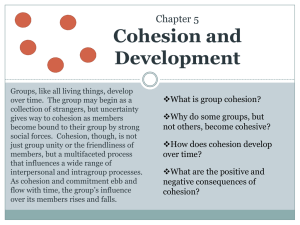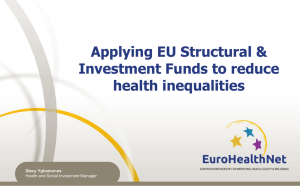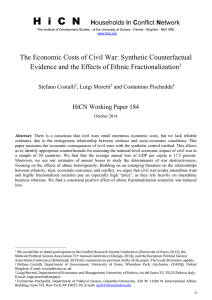Tracking Structural Development Processes through the Inter
advertisement
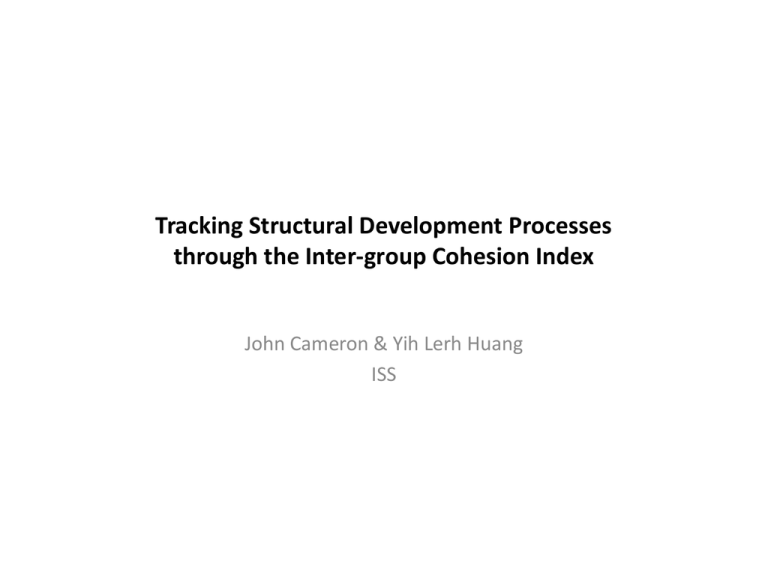
Tracking Structural Development Processes through the Inter-group Cohesion Index John Cameron & Yih Lerh Huang ISS “All happy families are alike; each unhappy family is unhappy in its own way.” – Tolstoy, in Anna Karenina What is Social Cohesion? “the ongoing process of developing a community of shared values, shared challenges and equal opportunity within Canada, based on a sense of trust, hope and reciprocity among all Canadians” Policy Research Sub-Committee on Social Cohesion (Canada) “a set of social processes that help instil in individuals the sense of belonging to the same community and the feeling that they are recognised as members of that community” Commissariat Général du Plan (France) Multi-dimensional Belonging Inclusion Participation Recognition Legitimacy Isolation Exclusion Non-involvement Rejection Illegitimacy Jenson (1998) Equality Inequality Rajulton et al. (2007) Common values Social order Social solidarity Social networks Place attachment Civic culture Social control Wealth disparities Social capital Identity Kearns and Forrest (2000) The ISS Inter-group Cohesion Index measures “the extent to which there is social cohesion between defined religious, ethnic, and linguistic groups, without degeneration into civil unrest or inter-group violence” Indices of Social Development: Project Overview (2011) Indicators: • Violent Demonstration • Deaths in Conflict • Inter-group Grievances • Civil Disorder • Internal Conflict • Terrorism Risk • Minority Rebellion Score • Log assassinations per log capita • Log guerrilla acts per log capita • Log riots per log capita • Terrorism • Log terrorist acts per log capita Only countries with complete data sets are presented (n=96) Inter-group Cohesion Index Summary 1990 1995 2000 2005 2010 Obs 106 103 116 158 158 Mean .5899623 .6572793 .5996492 .6093794 .5528531 Std. Dev. .1009363 .0919776 .1341715 .0760247 .0854517 Min .0000000 .3840644 .2491713 .3515432 .0800696 Max .7447424 .8023122 .8744453 .7420220 .7008806 Includes all countries with a score for that chronological data-point ISDs Mean Scores Weighted by Country Population, 1990-2010 Only countries with complete data sets are presented (n=96) Adverse events and the onset and depth of declines • 1997 Asian Financial Crisis • Post-9/11 • ‘War on Terror’ Low Income Group Peaked around 1995 Peaked around 2000 Lower Middle Income Group Peaked around 1995 Peaked around 2000 Upper Middle Income Group Peaked around 1995 Peaked around 2000 High Income Group Peaked around 1995 Peaked around 2000 10 Year Change cohesion Index Peaked ~ 1995 Peaked ~ 2000 Mann-Whiney test -0.079 -0.140 p<0.000 Average 10 Year Change post-‘peak’ Peaked ~ 1995 Peaked ~ 2000 Mann-Whiney test cohesion Index -0.079 -0.140 p<0.000 gdppc growth 34.6% 19.4% p<0.000 10 post-peak change: gdppc vs Inter-group Cohesion – High Income 10 year change (2000-2010): gdppc vs Inter-group Cohesion – Upper Income Only countries with complete data sets are presented (n=64) Clubs & Associations Index’s correlation with Inter-group Cohesion Index Conclusion • Significant decline in the Inter-group Cohesion Index between 1995 and 2010. • Some ‘regional’ differences in the timing of the downturn • Greater resilliance in Cohesion scores and less impact on gdppc growth rates in the 1995 cohort even when controlling for initial gdppc levels using two approaches • ‘varieties of capitalism’ • Small group solidarity as a response to structural insecurities 10 post-peak change: gdppc vs Inter-group Cohesion – Lower Income 10 post-peak change: gdppc vs Inter-group Cohesion – Lower Middle Income 10 post-peak change: gdppc vs Inter-group Cohesion – Upper Middle Income


